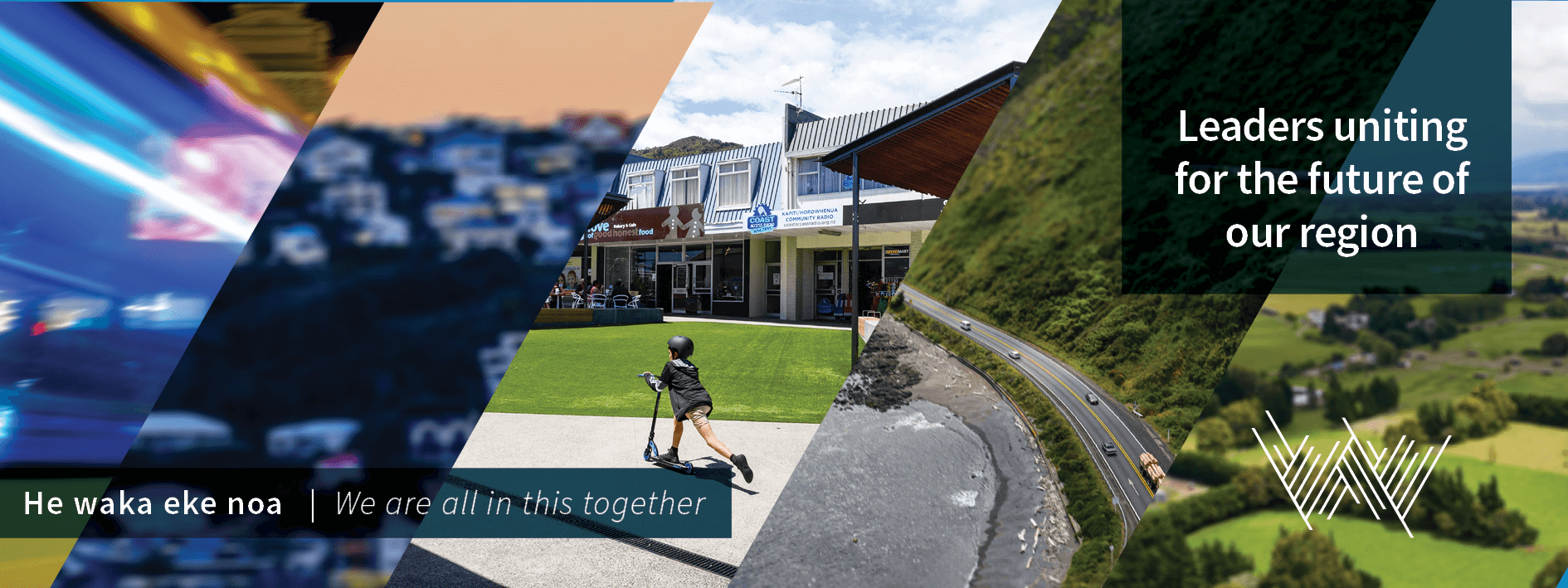Kohitātea | January 2024
Welcome to our first eNews of 2024! Featuring:
- Welcome to 2024 – WRLC Director’s message
- New Chair and Deputy Chair for WRLC
- Regional Industrial land study project kicks off
- Inclusionary Housing Seminar 20 February
- Choreography of Place: Thought Leadership article from WSP
- Good Reads / listens: books we enjoyed over summer break
Welcome from WRLC Director Kim Kelly
Kia ora koutou and welcome to 2024!
As we collectively settle into the new year, our work programme is a mix of continuing efforts from 2023: including the Priority Development Areas, the Regional Economic Development Plan and finalising the Future Development Strategy, as well as embarking on new initiatives, including phase two of the Regional Climate Impacts Assessment Project: The Regional Adaptation Plan, and – in the interests of supporting the Implementation Plan for the Future Development Strategy, the Committee is also exploring a Regional Deal for our region.
Amidst the constant change of the complex nature of our work, our mission remains the same: to enable and activate cross-boundary collaboration to support our region to thrive.
We hope you enjoy this eNews, do sign up to our webinars, and please get in touch with suggestions for future editions at: hello@wrlc.org.nz.
~ Kim KellyProgramme Director, WRLC Secretariat
Meet WRLC’s new Chair and Deputy Chair
We’re excited to share that a new Chair and Deputy Chair have been selected by the Wellington Regional Leadership Committee at the December meeting last year. WRLC previously had an independent chair, and decided to select people for these roles from within its membership of local government and iwi members.
The committee decided by vote that both local government and iwi could be represented in these roles. The Chair role, as a matter of process, still needs to be confirmed by GWRC as the Administering Authority, at its meeting in February.
Those selected are Darrin Apanui (Rangitāne Tū Mai Rā Trust member) as Chair and Daran Ponter (Greater Wellington Regional Council member) as Deputy Chair.
Reflecting on the year ahead, Darrin Apanui says, “The Region is a taonga of opportunity. Made up of diverse cultures, people, environments and businesses. I, with Daran, the Deputy Chair, and the rest of the committee of Mayors and Mana Whenua Leaders commit to ensuring our mahi contributes to enhancing our taonga for future generations.”
We look forward to our ‘dazzling’ new chairs shining the way forward in 2024!

Regional Industrial Land Study Project Commences
How much industrial land will be needed in future to support our region’s business and innovation sectors? The Housing and Business Development Capacity Assessment (HBA) undertaken as part of the Future Development Strategy projected that by December 2051, the region will require another 697 hectares of industrial land. We recently kicked off a regional project to find out how much land is required (taking into account any changes by 2051) and also identifying the optional locations for this industrial land. The Property Group is undertaking this work for the WRLC and during this process we will talk with a range of stakeholders to inform findings, including business and developers.

Seminar: Inclusionary Housing

Inclusionary Housing:
What is it and why should we take it seriously?
A Pathway forward for Aotearoa
12:00-1:00PM, TUES 20.02.24
Presenter: Chris Glaudel, Deputy CEO of Community Housing Aotearoa.
In this webinar, Chris Glaudel, Deputy CEO of Community Housing Aotearoa, will discuss the ‘what, why and how’ of Inclusionary Housing in Aotearoa, and how it offers a positive pathway forward out of our country’s housing crisis.
Affordable healthy homes are at the heart of strong communities. Like clean water, like hospitals, like transport, they are essential infrastructure in the lives of our people. And yet, a lack of affordable healthy housing is one of the biggest challenges facing Aotearoa today.
Done well, inclusionary housing is a powerful lever to address our affordable housing shortage.
The webinar will conclude with a Q&A with the speakers. We hope you will join us.

WellingtonNZ making excellent progress on the Regional Economic Development Plan
Read on to discover how the REDP has helped launch a local screen producer onto the global stage, details on the upcoming Climate Response accelerator, and Food Innovation Workshops.
Choreography of Place
This is the fourth piece in a series of articles by WSP exploring issues and opportunities for the future design and development of regions across Aotearoa New Zealand. Read on to learn about the vision and ideas behind ‘Choreography of Place’ and what it asks of us in our relationships to place.
Co-written by WSP Urban Design Leaders, Haley Hooper, Alan Whiteley and key members of the WSP Te Whanganui-a-tara team; Ashleigh Ward, Amy Te Maro, Akira McTavish-Huriwai and Alyce Lysaght.
What is the future choreography of ‘people’ together with ‘place’ in our ever-changing world? How do we all contribute to and care for the places we find ourselves in, looking after them and leaving them better for those who are yet to come? What really is ‘livability’ in Aotearoa? What is the role of design, story, collective composition and creativity? What is the role of respect and reciprocity? How do different places and environments shape us through various periods of our lives? Places are constantly teaching us, nurturing us, creating memories ‘over-one, under-one’ woven, interlaced threads of the fibre that we each came from, forming a tapestry of time, people and place that is carried with us, henceforward wherever we may go.
Recommended read: How Big Things Get Done
By Professor Bent Flyvbjerg and Dan Gardner
If you’ve ever wondered, ‘Why is it that very big and difficult things always come in late and over budget, and sometimes don’t even deliver the intended benefits?” – then this book is for you.

Above: a visual depiction of one of the book’s key recommendations: “Plan slow, act fast.”
Bent Flyvbjerg‘s own curiosity on this topic, led him to build the world’s first database tracking the delivery of 16,000 major projects – including large buildings, tunnels, bridges, dams, power stations, highways, wind farms – even Olympic Games. It doesn’t paint a pretty portrait: only 8.5% of projects deliver on time and to budget, and only 0.5% nail cost, time, and benefits. Put another way: 99.5% of large projects fail to deliver as promised.
To understand why, the authors deepdive into key psychological concepts that are driving how things get done: cognitive bias, political bias, strategic misrepresentation, optimism bias, uniqueness bias, planning fallacy, overconfidence bias, hindsight bias, availability bias, base-rate fallacy, and more.
This book would make great compulsory reading for any Infrastructure Project Manager. The final chapter: Coda – 11 Heuristics for Better Project Leadership, is an easily digestible summary of the book’s main takeaways. Authors Flyvjberg and Gardner draw on diverse examples from history, including the Sydney Opera House, the Empire State Building, T5 terminal at Heathrow – as well as home renovations gone awry (TW!). The concept of ‘uniqueness bias’ is entertainingly explained with an example of how even, “the world’s leading expert on unconscious bias” – Daniel Kahneman – fell prey to uniqueness bias in his own project!
Understanding why projects succeed or fail has been the life’s work of Oxford professor Bent Flyvbjerg, dubbed “the world’s leading megaproject expert.” In How Big Things Get Done, he identifies the errors in judgment and decision-making that lead projects, big or small, to fail, and shares research-based principles that will support you to succeed. For example:• Understand your odds. If you don’t know them, you won’t win.• Plan slow, act fast. Getting to the action quick feels right. But it’s wrong.• Think right to left. Start with your goal, then identify the steps to get there.• Find your Lego. Big is best built from small.• Be a team maker. You won’t succeed without an “us.”• Master the unknown unknowns. Most think they can’t, so they fail. Flyvbjerg shows how you can.• Know that your biggest risk is you.

Signals from the future
Join this free impact session with foresight practitioner Melissa Clark-Reynolds, Thurs 1st Feb 10am to uncover the ten signals that are top of mind for her, and how they may impact you. Take a glimpse into how future-focused leaders can use signals to drive strategy.
About the Wellington Regional Leadership Committee
WRLC is a joint regional partnership which brings together Iwi leaders, Mayors, Ministers of Government, and an independent chair, to work collaboratively on cross-boundary, growth-related challenges in the Wellington-Wairarapa-Horowhenua region.
WRLC exists to find better ways of working together to cultivate a region where people want to live, work and thrive.
Our projects cover five broad key areas that are integral to our shared growth-related cross-boundary challenges. These five areas are iwi capacity, housing, climate, transport and economic development and recovery. Find out more about our work on our project page, and if you’d like to talk or collaborate – get in touch at hello@wrlc.org.nz.






